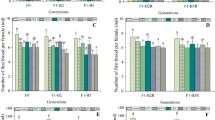Abstract
In recent years, pharmaceuticals and personal care products (PPCPs) that remain in the environment have become increasingly important. Carbamazepine (CBZ) is a widely used antiepileptic drug that has a potential impact on the environment due to its Physico-chemical properties, which are rarely eliminated in conventional water treatment. Daphnia magna Straus (DMS) is a fundamental link of aquatic ecosystem chain. The influence of CBZ toxicity on DMS can effectively reflect the effects of CBZ toxicity on the aquatic environment. In this study, DMS was used as a subject to assess the chronic effects of CBZ exposure. It was found that after 21 days of CBZ exposure, the breeding frequency, the total number of eggs laid, body length, and intrinsic growth rate of DMS decreased with increasing CBZ concentrations. Maximum reductions of 69% in fecundity and 60% in fertility were observed at 0.5 mg/L CBZ, while a maximum reduction of 60% in body length was observed at 0.001 mg/L CBZ concentration. The integrated biomarker response version 2 (IBRv2) analysis suggests that with the increase in CBZ concentration, the overall negative effect of CBZ on DMS was enhanced.



Similar content being viewed by others
References
Brandhof EJVD, Montforts M (2010) Fish embryo toxicity of carbamazepine, diclofenac and metoprolol. Ecotoxicol Environ Saf 73(8):1866
Chen H, Gu X, Zeng Q, Mao Z, Liang X, Martyniuk CJ (2019) Carbamazepine disrupts molting hormone signaling and inhibits molting and growth of Eriocheir sinensis at environmentally relevant concentrations. Aquat Toxicol 208:138–145
Dietrich S, Ploessl F, Bracher F, Laforsch C (2010) Single and combined toxicity of pharmaceuticals at environmentally relevant concentrations in daphnia magna—a multigenerational study. Chemosphere 79(1):60–66
Duarte IA, Reis-Santos P, Fran AS, Cabral H, Fonseca VF (2017) Biomarker responses to environmental contamination in estuaries: a comparative multi-taxa approach. Aquat Toxicol 183:31–34
Ekpeghere KI, Sim WJ, Lee HJ, Oh JE (2018) Occurrence and distribution of carbamazepine, nicotine, estrogenic compounds, and their transformation products in wastewater from various treatment plants and the aquatic environment. Sci Total Environ 640–641:1015–1023
Fraz S, Lee AH, Wilson JY (2018) Gemfibrozil and carbamazepine decrease steroid production in zebrafish testes (Danio rerio). Aquat Toxicol 198:1–9
Fu J, Lee WN, Coleman C, Nowack K, Carter J, Huang CH (2019) Removal of pharmaceuticals and personal care products by two-stage biofiltration for drinking water treatment. Sci Total Environ 664:240–248
Ladewig V, Jungmann D, Kohler HR, Schirling M, Triebskorn R, Nagel R (2006) Population structure and dynamics of Gammarus fossarum (Amphipoda) upstream and downstream from effluents of sewage treatment plants. Arch Environ Contam Toxicol 50:370–383
Leblanc GA, Mclachlan JB (2010) Molt-independent growth inhibition of Daphnia magna by a vertebrate antiandrogen. Environ Toxicol Chem 18:1450–1455
Li ZH, Zlabek V, Velisek J, Grabic R, Machova J, Kolarova J et al (2011) Acute toxicity of carbamazepine to juvenile rainbow trout (Oncorhynchus mykiss): effects on antioxidant responses, hematological parameters and hepatic. Ecotox Environ Saf 74:319–327
Lürling M, Sargant E, Roessink I (2010) Life-history consequences for Daphnia pulex exposed to pharmaceutical carbamazepine. Environ Toxicol 21:172–180
Marques CR, Nelson A, Fernando G (2004) Life-history traits of standard and autochthonous cladocerans: II. Acute and chronic effects of acetylsalicylic acid metabolites. Environ Toxicol 19:527–540
Nkoom M, Lu G, Liu J, Yang H, Dong H (2019) Bioconcentration of the antiepileptic drug carbamazepine and its physiological and biochemical effects on Daphnia magna. Ecotox Environ Saf 72:11–18
Oda S, Tatarazako N, Watanabe H, Morita M, Iguchi T (2005) Genetic differences in the production of male neonates in Daphnia magna exposed to juvenile hormone analogs. Chemosphere 61:1168–1174
Oropesa AL, Floro AM, Palma P (2016) Assessment of the effects of the carbamazepine on the endogenous endocrine system of Daphnia magna. Environ Sci Pollut Res Int 23(17):17311–17321
Palma P, Palma VL, Fernandes RM, Soares AM, Barbosa IR (2009) Endosulfan sulphate interferes with reproduction, embryonic development and sex differentiation in Daphnia magna. Ecotox Environ Saf 72:344–350
Qiang L, Cheng J, Yi J, Rotchell JM, Zhu X, Zhou J (2016) Environmental concentration of carbamazepine accelerates fish embryonic development and disturbs larvae behavior. Ecotoxicology 25:1426–1437
Rao YF, Liang Q, Yang H, Chu WJ (2014) Degradation of carbamazepine by Fe(II)-activated persulfate process. J Hazard Mater 268:23–32
Sanchez W, Burgeot T, Porcher JM (2013) A novel “Integrated Biomarker Response” calculation based on reference deviation concept. Environ Sci Pollut R 20:2721–2725
Songlin W, Ning Z (2016) Removal of carbamazepine from aqueous solution using sono-activated persulfate process. Ultrason Sonochem 29:156–162
Thomas H (2002) Occurrence, fate, and removal of pharmaceutical residues in the aquatic environment: a review of recent research data. Toxicol Lett 131:5–17
Trombini C, Hampel M, Blasco J (2019) Assessing the effect of human pharmaceuticals (carbamazepine, diclofenac and ibuprofen) on the marine clam Ruditapes philippinarum: an integrative and multibiomarker approach Aquatic toxicology. Aquat Toxicol 208:146–156
Yan Q, Zhang YX, Jia K, Gan XM, Peng XY, Guo JS (2015) A preliminary study on the occurrence of pharmaceutically active compounds in the river basins and their removal in two conventional drinking water treatment plants in Chongqing, China. Clean Soil Air Water 43:794–803
Acknowledgements
The present study was supported by Grants from the National Natural Science Foundation of China [No. 41671320]; the National Science and Technology Major Project of the Ministry of Science and Technology of China [No. 2016YFD0201203]; the Natural Science Foundation of Shandong Province, China [Nos. JQ201711 and ZR2016JL029].
Author information
Authors and Affiliations
Corresponding author
Rights and permissions
About this article
Cite this article
Tian, Y., Xia, X., Wang, J. et al. Chronic Toxicological Effects of Carbamazepine on Daphnia magna Straus: Effects on Reproduction Traits, Body Length, and Intrinsic Growth. Bull Environ Contam Toxicol 103, 723–728 (2019). https://doi.org/10.1007/s00128-019-02715-w
Received:
Accepted:
Published:
Issue Date:
DOI: https://doi.org/10.1007/s00128-019-02715-w




